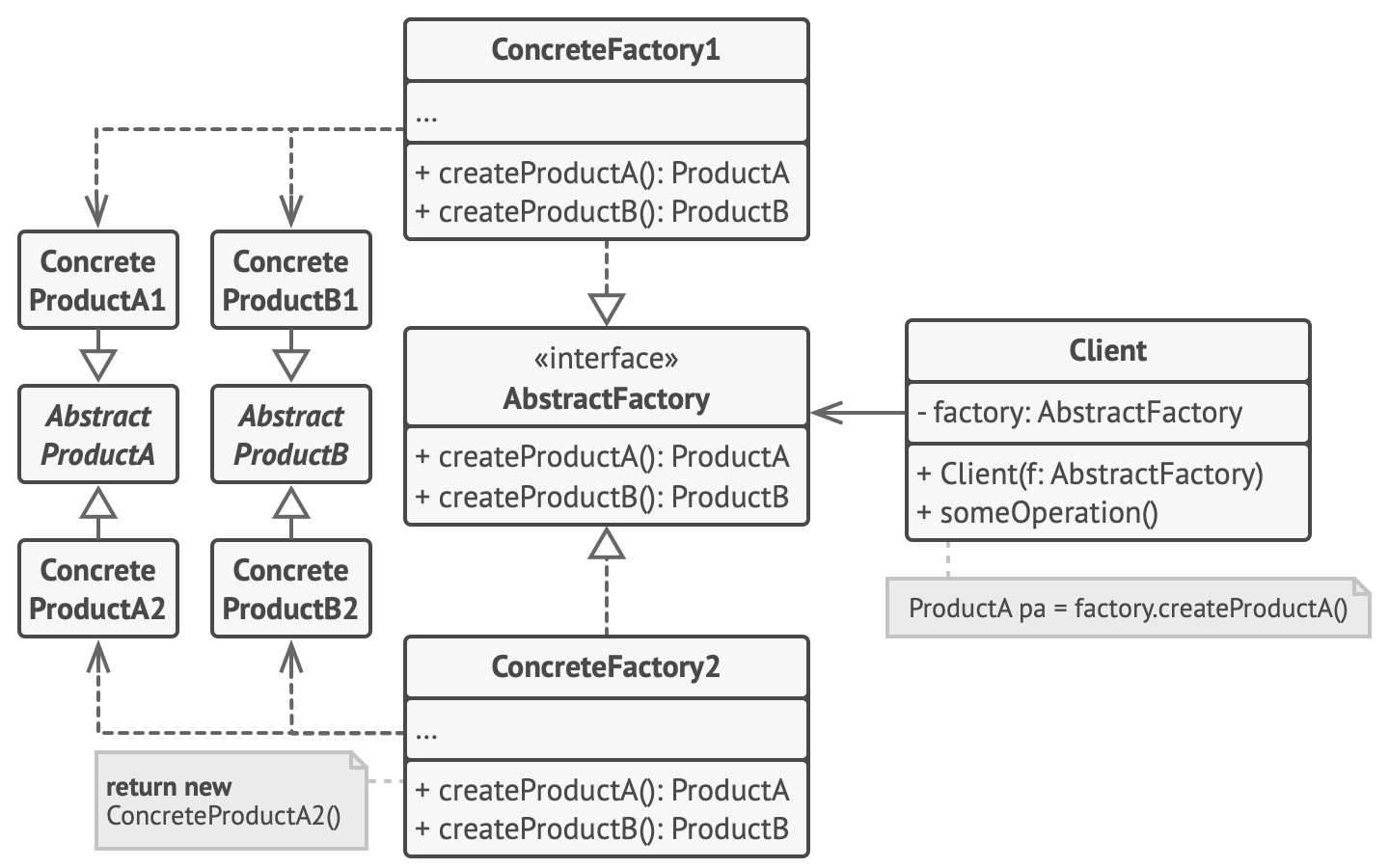
추상 팩토리: 관련 객체들의 구상 클래스들을 지정하지 않고도 관련 객체들의 모음을 생성할 수 있도록 하는 생성패턴
문제
- 가구 판매장을 위한 프로그램을 만들고 있다. 코드에는 다음 클래스들이 있다
- 제품군: 의자, 소파 커피 테이블 등등..
- 제품군의 여러 변형: 각각은 현대식, 빅토리안, 아르데코 양식 등을 가질 수 있음
- 새로운 개별 가구 객체를 생성할 때 새로운 객체는 같은 패밀리 내에 있는 다른 가구 객체들과 일치하는 스타일을 가져야 함
해결책
-
각 제품군에 해당되는 개별적인 인터페이스를 명시적으로 선언하고, 제품의 모든 변형은 이 인터페이스를 따르게 해야 함

-
제품 패밀리 내의 모든 개별 제품들의 생성 메서드들이 목록화 되어 있는 인터페이스인 추상 팩토리 패턴 선언

-
추상 팩토리 인터페이스를 기반으로 각 특성의 제품을 생성하는 별도의 팩토리 클래스 생성
-
클라이언트 코드는 자신에 해당하는 추상 인터페이스를 통해 제품들 모두와 작동해야 함
프로그램은 초기화 단계에서 구상 팩토리 객체를 생성하고, 환경, 구성 설정에 따라 팩토리 유형을 선택함
구조

// 생성할 모든 객체들을 담은 추상 패토리 인터페이스
interface AbstractFactory {
createProductA(): AbstractProductA;
createProductB(): AbstractProductB;
}
// 구상 팩토리에서 추상 팩토리를 바탕으로 각각의 특성에 맞는 객체 생성
class ConcreteFactory1 implements AbstractFactory {
public createProductA(): AbstractProductA {
return new ConcreteProductA1();
}
public createProductB(): AbstractProductB {
return new ConcreteProductB1();
}
}
class ConcreteFactory2 implements AbstractFactory {
public createProductA(): AbstractProductA {
return new ConcreteProductA2();
}
public createProductB(): AbstractProductB {
return new ConcreteProductB2();
}
}
// 제품군의 모든 변형 객체를 생성해주는 객체 생성 인터페이스 구현
// 여기서는 A제품을 생성하는 인터페이스
interface AbstractProductA {
usefulFunctionA(): string;
}
// 구체적인 클래스 구현, 각각의 객체는 객체의 특성에 맞추어 구현됨
class ConcreteProductA1 implements AbstractProductA {
public usefulFunctionA(): string {
return 'The result of the product A1.';
}
}
class ConcreteProductA2 implements AbstractProductA {
public usefulFunctionA(): string {
return 'The result of the product A2.';
}
}
//한번더 반복
interface AbstractProductB {
usefulFunctionB(): string;
anotherUsefulFunctionB(collaborator: AbstractProductA): string;
}
// A와 인터페이스, 객체 생성 방법은 동일하나 다른 특성을 갖는 객체 생성
class ConcreteProductB1 implements AbstractProductB {
public usefulFunctionB(): string {
return 'The result of the product B1.';
}
public anotherUsefulFunctionB(collaborator: AbstractProductA): string {
const result = collaborator.usefulFunctionA();
return `The result of the B1 collaborating with the (${result})`;
}
}
class ConcreteProductB2 implements AbstractProductB {
public usefulFunctionB(): string {
return 'The result of the product B2.';
}
public anotherUsefulFunctionB(collaborator: AbstractProductA): string {
const result = collaborator.usefulFunctionA();
return `The result of the B2 collaborating with the (${result})`;
}
}
// 클라이언트들은 추상 인터페이스를 통해 원하는 특성의 객체만를 사용할 수 있게 됨
function clientCode(factory: AbstractFactory) {
const productA = factory.createProductA();
const productB = factory.createProductB();
console.log(productB.usefulFunctionB());
console.log(productB.anotherUsefulFunctionB(productA));
}
/*
Client: Testing client code with the first factory type...
The result of the product B1.
The result of the B1 collaborating with the (The result of the product A1.)
*/
console.log('Client: Testing client code with the first factory type...');
clientCode(new ConcreteFactory1());
console.log('');
/*
Client: Testing the same client code with the second factory type...
The result of the product B2.
The result of the B2 collaborating with the (The result of the product A2.)
*/
console.log('Client: Testing the same client code with the second factory type...');
clientCode(new ConcreteFactory2());적용
- 관련된 객체들의 다양한 패밀리들과 작동해야 하지만, 구체적인 클래스들에 의존하고 싶지 않을 때 사용
- 클래스들을 나중에 추가하게 될 수도 있음
- 의도하지 않은 잘못된 객체를 생성할 위험을 사전에 방지해줌
- 코드에 클래스가 있고, 클래스의 팩토리 메서드들의 집합의 기본책임지 뚜렷하지 않을 때 사용
- 클래스가 여러 유형을 상대할 경우 팩토리 클래스를 분리하거나 추상 팩토리 구현으로 변경하는 것이 좋음
구현 방법
- 제품군(의자, 테이블 등) - 제품군에서 파생된 변형품(동그란 의자, 네모난 테이블 등)을 맵핑
- 모든 제품 변형들에 대한 추상 제품 인터페이스 선언 (의자 인터페이스, 테이블 인터페이스)
- 모든 구체적 제품 클래스들에 대해 추상 제품 인터페이스를 따르게 함
- 추상 팩토리 인터페이스를 모든 추상 제품들에 대한 생성 메서드들의 집합과 함께 선언
- 각각의 변형품 집합에 대해 하나의 구상 팩토리 클래스 집합 구현
- 앱의 어딘가에 팩토리 초기화 코드를 작성하고 제품을 생성하는 모든 클래스에 전달
초기화 코드는 앱 설정, 환경에 따라 구상 팩토리 클래스 중 하나를 결정해야 함 - 모든 제품 생성자에 대한 직접 호출을 찾고, 이들을 팩토리 객체에 대한 적절한 생성 메서드에 의한 호출로 교체
장단점
- 팩토리에서 생성되는 객체들의 상호호환 보장
- 실제 객체와 클라이언트 코드 사이에 결합을 약하게 해줌으로써 개방/폐쇄 원칙 준수
- 제품 생성코드를 한 곳으로 몰아 단일 책임 원칙 준수
- 패턴과 함께 새로운 인터페이스, 클래스들이 많이 도입되기 때문에 코드가 복잡해질 수 있음
출처:
https://refactoring.guru/ko/design-patterns/abstract-factory
